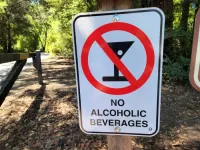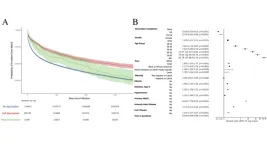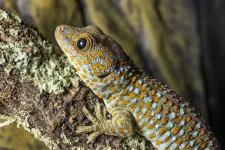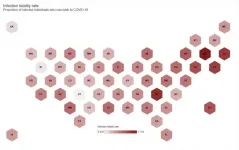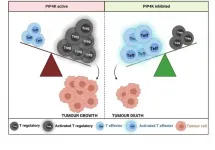(Press-News.org) Correspondence shows troubling interactions between U.S. officials and the alcohol industry
By Kimberly Flynn
PISCATAWAY, NJ — Growing evidence exists that the alcohol industry uses a variety of strategies to influence public policy in a way that is advantageous to its own corporate interests, rather than the interest of public health. Recent communication between employees of the National Institute on Alcohol Abuse and Alcoholism (NIAAA) and alcohol industry groups shows extensive interaction on policy-relevant scientific issues, according to a new study in the Journal of Studies on Alcohol and Drugs.
Researchers at the University of York in the United Kingdom conducted a thematic content analysis on 4,784 pages of email correspondence obtained through Freedom of Information Act requests. The emails were sent between 43 NIAAA staff members and representatives of 15 alcohol industry groups—including producers and trade associations—between 2013 and 2020.
The analysis focused on 12 leaders at the NIAAA and various contacts in the alcohol industry: representatives of two alcohol producers (AB InBev and Diageo), two trade associations (the Beer Institute and the Distilled Spirits Council of the United States [DISCUS]), and the International Alliance for Responsible Drinking (IARD).
The researchers—Gemma Mitchell, Ph.D., and Jim McCambridge, Ph.D.—found that the NIAAA leaders provided the alcohol industry with extensive information about scientific research and its policy implications. The NIAAA leaders communicated often with their industry contacts via email, telephone, and in-person meetings.
“Discussions were facilitated by the willingness of NIAAA leaders to meet with industry and have other informal contacts, as well as NIAAA leadership presence at industry-sponsored and other events,” the authors write. “Key industry actors asked NIAAA leaders for help on science and policy issues. At times, NIAAA leaders heavily criticized public health research and researchers in correspondence with industry.”
The authors also mention the problem of the “revolving door”: Some NIAAA leaders subsequently went to work for industry. This is one way in which close relationships are forged between NIAAA leadership and key industry groups, allowing for the free flow of privileged information and other questionable practices.
Mitchell and McCambridge point to the scope of their data over a long period as a strength of their research, and they also used publicly available data whenever possible to confirm any information contained in the emails. They say their findings add to other recent studies that identify the long-term effects of industry influence on alcohol science.
“Ongoing relationships between NIAAA leaders and the alcohol industry meant that industry representatives could access privileged information on a wide range of topics, from the US Dietary Guidelines to alcohol and cancer,” says Mitchell. “Our findings are hugely concerning, and we hope the NIAAA and National Institutes of Health will regard this report not as presenting a public relations challenge to be managed, but as posing a set of major scientific challenges to which it must rise.”
“The depth of the relationships between NIAAA senior leaders and key alcohol industry contacts uncovered here is disturbing,” says McCambridge. “The study findings provide examples of alcohol public health science being opposed rather than championed by NIAAA leaders, at least in their direct communications with industry. There is an urgent need to understand better the nature of this problem. The implications are profound when one considers that NIAAA funds the majority of the world’s alcohol science.”
An accompanying editorial by Thomas Babor, Ph.D., M.P.H., editor of the Journal of Studies on Alcohol and Drugs, underlines the importance of monitoring how the alcohol industry funds research projects and how it is involved in scientific activities.
“What is described in the Mitchell and McCambridge article, and related evaluations . . . provide strong evidence that alcohol industry influence has penetrated the highest levels of the NIAAA in ways that threaten public health at both a national and global level,” Babor writes.
-----
Mitchell, G., & McCambridge, J. (2023). Interactions between the U.S. National Institute on Alcohol Abuse and Alcoholism and the alcohol industry: Evidence from email correspondence 2013–2020. Journal of Studies on Alcohol and Drugs, 84, 11–26. doi:10.15288/jsad.22-00184
-----
For interview requests from U.K.-based media, please arrange an interview with Gemma Mitchell, Ph.D. (media contact Sarah Manning, sarah.manning@stir.ac.uk).
For all interview requests from non-U.K. media, please arrange an interview with Jim McCambridge (media contact Alistair Keely, alistair.keely@york.ac.uk).
-----
The Journal of Studies on Alcohol and Drugs is published by the Center of Alcohol & Substance Use Studies at Rutgers, The State University of New Jersey. It is the oldest substance-related journal published in the United States.
-----
The Journal of Studies on Alcohol and Drugs considers this press release to be in the public domain. Editors may publish this press release in print or electronic form without legal restriction. Please include a byline and citation.
-----
To view the public domain, stock-photo database of alcohol, tobacco and other drug-related images compiled by the Journal of Studies on Alcohol and Drugs, please visit jsad.com/photos.
END
Correspondence shows troubling interactions between US officials and the alcohol industry
2023-02-20
ELSE PRESS RELEASES FROM THIS DATE:
COVID-19 vaccination linked to fewer cardiac events
2023-02-20
New York, NY [February 20, 2023] – Analyzing the most extensive datasets in the United States, researchers from the Icahn School of Medicine at Mount Sinai have revealed that vaccination against COVID-19 is associated with fewer heart attacks, strokes, and other cardiovascular issues among people who were infected with SARS-CoV-2, the virus that causes COVID-19.
The research letter, “Impact of Vaccination on Major Adverse Cardiovascular Events in Patients with COVID-19 Infection,” was published in the Journal of the American College ...
Pathways of memory: anthropological poetry at SAPIENS magazine
2023-02-20
Contact: Chip Colwell
chip@sapiens.org
212.683.5000
New York, NY – SAPIENS magazine is excited to share news of its 2023 poet-in-residence: Toiba Naseema. Through this position, Naseema will use poetry, film, and music to reflect on memory, occupation, and resilience in Indian-occupied Kashmir.
Naseema earned a master’s degree in mass communication, specializing in documentary filmmaking, and she is currently pursuing a master’s in anthropology at the University of Kashmir. She has been involved as an international ...
No safety concerns seen with use of dapivirine vaginal ring during third trimester of pregnancy, according to interim results of DELIVER study
2023-02-20
A vaginal ring containing the antiretroviral drug dapivirine posed no safety concerns when used in the third trimester of pregnancy, according to results to date from the first study of the dapivirine ring during pregnancy and one of only a few studies of an HIV prevention product in pregnant cisgender women.
The ongoing Phase IIIb study, known as DELIVER, or MTN-042, was designed to evaluate the safety and acceptability of the monthly dapivirine vaginal ring, a new HIV prevention method approved in several African countries and recommended by the World Health Organization (WHO), as well as ...
Doxycycline does not prevent STIs among cisgender women
2023-02-20
February 20, 2023 – Researchers from the University of Washington (UW), Kenya Medical Research Institute (KEMRI), and Hennepin Healthcare Research Institute (HHRI) announced results at CROI from a clinical trial demonstrating that doxycycline taken after sex does not prevent bacterial sexually transmitted infections (STIs) – chlamydia or gonorrhea – among cisgender women. The dPEP Kenya Trial was conducted in Kisumu, Kenya, to evaluate the effectiveness of doxycycline postexposure prophylaxis (PEP) to prevent bacterial STIs. The results of the study have been highly anticipated, as this is the first study of doxycycline PEP among cisgender ...
Geckos know their own odor
2023-02-20
Geckos can use their tongue to differentiate their own odor from that of other members of their species, as researchers from the University of Bern have shown in a new experimental study. The findings show that geckos are able to communicate socially, meaning that they are more intelligent than was previously assumed.
Self-recognition is the ability to detect stimuli which come from oneself. We as people, and also some animals, can identify ourselves visually when we look in the mirror. However, not all animals rely on their sense of sight, first and foremost. Geckos, and also other lizards ...
Scientists model 'true prevalence' of COVID-19 throughout pandemic
2021-07-26
Government officials and policymakers have tried to use numbers to grasp COVID-19's impact. Figures like the number of hospitalizations or deaths reflect part of this burden. Each datapoint tells only part of the story. But no one figure describes the true pervasiveness of the novel coronavirus by revealing the number of people actually infected at a given time -- an important figure to help scientists understand if herd immunity can be reached, even with vaccinations.
Now, two University of Washington scientists have developed a statistical framework that incorporates key COVID-19 data -- such as case counts and deaths due to COVID-19 -- to model the true prevalence of this disease in the United States and individual states. Their approach, published the ...
New breakthrough to help immune systems in the fight against cancer
2021-07-26
New research has identified potential treatment that could improve the human immune system's ability to search out and destroy cancer cells within the body. Scientists have identified a way to restrict the activity of a group of cells which regulate the immune system, which in turn can unleash other immune cells to attack tumours in cancer patients.
"A patient's immune system is more than able to detect and remove cancer cells and immunotherapy has recently emerged as a novel therapy for many different types of cancers." Explained Nullin Divecha, Professor of Cell Signalling at the University of Southampton who led the study. "However, cancer cells can generate a microenvironment ...
Through the thin-film glass, researchers spot a new liquid phase
2021-07-26
Research published in the Proceedings of the National Academy of Sciences describes a new type of liquid in thin films, which forms a high-density glass. Results generated in this study, conducted by researchers in Penn's Department of Chemistry, demonstrate how these glasses and other similar materials can be fabricated to be denser and more stable, providing a framework for developing new applications and devices through better design.
Glass is typically created through solidification, or falling out of equilibrium, of a liquid when it is cooled to a temperature where its motion arrests. The structure of a glass closely ...
Administering opioids to pregnant mice alters behavior and gene expression in offspring
2021-07-26
Mice exposed to the opioid oxycodone before birth experience permanent changes in behavior and gene expression. The new research published in eNeuro highlights a need to develop safer types of painkillers for pregnant women.
Opioids like oxycodone are prescribed to pregnant women to treat pain, but the drugs may affect the fetus, too. Opioids can pass through the placenta, binding to receptors in the fetal brain, which can lead to opioid withdrawal in newborn babies. The long-term consequences of prenatal opioid exposure haven't been fully studied, however.
To explore this, Martin et al. administered oxycodone to female mice every day for the two weeks prior ...
Brain's 'memory center' needed to recognize image sequences but not single sights
2021-07-26
A new MIT study of how a mammalian brain remembers what it sees shows that while individual images are stored in the visual cortex, the ability to recognize a sequence of sights critically depends on guidance from the hippocampus, a deeper structure strongly associated with memory but shrouded in mystery about exactly how.
By suggesting that the hippocampus isn't needed for basic storage of images so much as identifying the chronological relationship they may have, the new research published in Current Biology can bring neuroscientists closer to understanding how the brain coordinates long-term visual memory across key regions.
"This offers the ...
